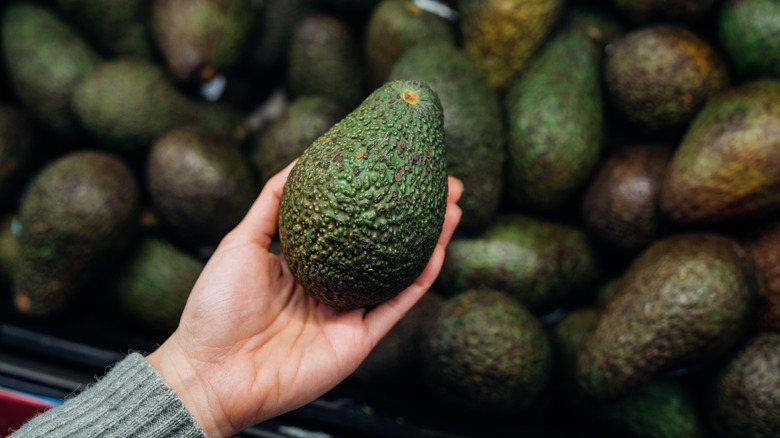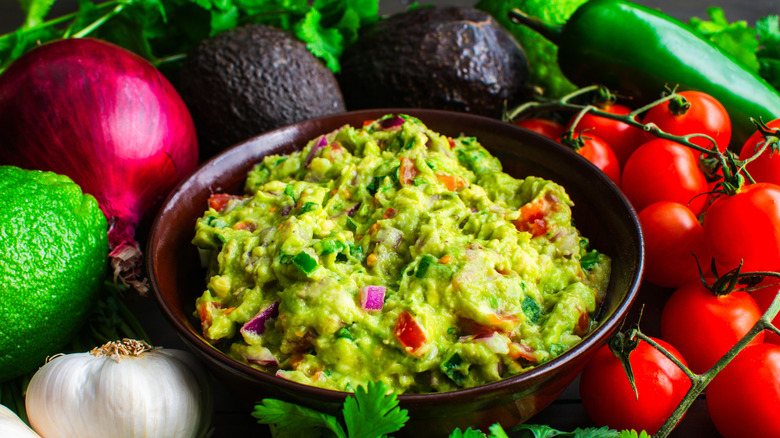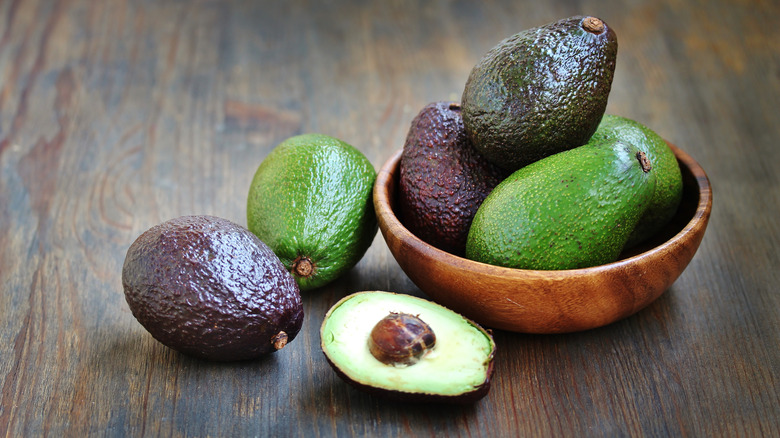What's The Difference Between Hass Avocados And Other Varieties
It feels like avocados exploded in popularity a few years ago. I'm a millennial, and growing up, no one talked about making avocado chips, fries, salad, or all the other zillion ways people have found to incorporate it into their diet. But, after hopping on the bandwagon, I sincerely feel like we missed out on this trend because avocados are so healthy and have become what feels like a kitchen staple at this point. They're super versatile with a luxurious, creamy texture and unctuous flavor.
Out of all the varieties available, the Hass avocado stands out as the most popular and widely consumed. Its dark, pebbly skin, buttery taste, and smooth consistency are perfect for tons of recipes. Yet, there's an entire world of other avocado varieties, such as Fuerte, Florida, Bacon, and Reed which offer unique characteristics and culinary possibilities. There's even a new variety called the Luna avocado that's making waves at the moment.
Choosing the right avocado usually depends on the dish you're preparing but you might also choose another type of avocado based on your preferences for taste and texture. Hass avocados dominate the market for good reason, but lesser-known varieties bring their own flair to the table. What's the difference between them all? In brief: You've got the firmer, lighter flavor of Fuerte, the mild sweetness of Bacon, and the somewhat similar but still slightly different creamy qualities of Reed.
Hass avocados are the year-round favorite
Hass avocados are synonymous with creamy goodness. Their rich, buttery texture and high oil content make them an automatic choice for avocado toast, smoothies, and guacamole (though you should be grilling them first to get a silky smooth texture in your guac). With their signature pebbly skin that turns from green to purplish-black when ripe, they're easy to identify.
Nutritionally, Hass avocados are chock full of heart-healthy monounsaturated fats, containing about 4.6 grams of fat and 50 calories per two-tablespoon serving. These fats contribute to their flavor and texture, which makes them a top choice among avocado enthusiasts. Additionally, their thick skin protects the fruit during transport and also extends its shelf life, so Hass avocados are a practical choice for retailers and consumers.
Another reason Hass avocados are so popular is their availability. They're grown primarily in California and Mexico and produced year-round, so you get a consistent supply. Their reliable ripening process makes them perfect for lots of dishes.
They're excellent for blending into sauces, mashing into dips, or acting as a substitute for butter in baking recipes. However, their higher fat content makes them more calorie-dense than other varieties, so portion control is key for those monitoring their calorie intake. Hass avocados are undeniably the market favorite, but other varieties are worth exploring for different culinary uses.
What do the other varieties have to offer?
The Fuerte is the second most popular avocado option. The skin on a Fuerte avocado is a lighter green color and it's smoother and thinner than a Hass. The taste is also sweeter while the flesh has a lower oil content. Therefore, they offer a lighter taste that appeals to those who prefer a less creamy consistency. However, Fuerte avocados have a shorter growing season and are less commonly found in stores.
Florida avocados, sometimes referred to as "lite avocados," are significantly larger and have bright green, smooth skin. They contain less fat than Hass avocados (about 3 grams per serving), resulting in a more subtle flavor but equally firm texture. They're ideal for slicing into salads or pairing with other ingredients in sandwiches.
Reed avocados are prominent during the summer and they're larger and rounder than most other avocados. The creamy element is comparable to a Hass and their flavor is robust. They're particularly well-suited for avocado dressings or spreads. Many enjoy the nutty undertones that Reed avocadoes have, making it a great choice for avocado toast.
Bacon avocados are underrated, with a creamy consistency similar to Hass, but with a slightly sweet flavor in tow. They have thin, green skin that makes them easy to peel but also more delicate, increasing their susceptibility to bruising. These avocados work well where a light avocado flavor is desired, such as sandwiches, wraps, or as a complement to other bold ingredients. I wouldn't suggest using it for something like guacamole where you're looking for that signature deep buttery flavor that you're accustomed to.


